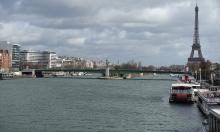Novichok plus Aleksei Navalny equals Skripal
Russian narcologist Yevgeny Kovalev commented on the method of finding Novichok poison in Aleksei Navalny's samples.
The head of the Institute of Toxicology at the Helmholtz Center in Munich, Martin Goettlicher, explained to t-online.de how Bundeswehr experts found Novichok poison in the samples of Russian opposition activist Aleksei Navalny. According to him, "this is difficult, but possible."
Novichok suppresses an important enzyme known as cholinesterase. This enzyme can be isolated from the body, and one can use a highly sensitive mass spectrometer to determine if there are any remnants of the active ingredient on it. This is a common and accurate method, and it may have proved to be successful now, Goettlicher said.
According to him, chemical warfare agents, such as Novichok, are designed in a way that they enter the body very easily: through skin, air or gastrointestinal tract.
Navalny, as it appears received the poison a few hours, maybe even a few minutes before he lost consciousness, the toxicologist said.
Novichok identification technology failed to be validated
Russian narcologist Yevgeny Kovalyov told Pravda.Ru that the techniques to detect chemicals have become supersensitive nowadays. For example, if one stays on the Moscow Ring Road for 5-6 hours, one can find both polonium and thallium in the samples afterwards.
In addition, the method of determination and the sensitivity of methods are of great importance, the expert continued. He explained that the technique for detecting Novichok through the link with cholinesterase is not publicly available, therefore it is not considered either approved or validated.
"Somewhere in Cyprus, in an ordinary laboratory, with the presence of certain instruments, I could reproduce this method. I have a spectrometer, I have basic reagents. I should be able to reproduce this method in Brazil, and in Russia, and anywhere - identically," said Evgeny Kovalev.
"All the talking is worthless until they publish the details of the technique used," he added.
Cockroach and Novichok poisons leave the same mark
Secondly, according to the specialist, "we still need to make sure that the molecule is the right one or not, and if we are talking about a technique, then one needs to know what concentration of these molecules is effective."
For example, in London, Chinese athletes were caught on clenbuterol, but it was found out later that they had eaten clenbuterol-containing poultry before, Yevgeny Kovalev said.
"The bottom line is that low concentrations do not affect the result, that is, the athletes were recognized clean," he added.
"There may also be similar substances. For example, when they exterminate cockroaches, they use organophosphates. Most of them are reversibly inhibited into cholinesterase, but, nevertheless, some are irreversible. If one extracts motor neurons from the spine, it may turn out that I may have the same substance in my body as the politician has," continued Evgeny Kovalev.
According to him, many toxicology clinics in the West, may have developed secret methods to identify Novichok poison after the Skripal case. If this is the case, then one needs to explain whether the dose of the poison was lethal or "incapacitating." Nothing like that was said in the case of Navalny poisoning.
Commenting on the assumption from the German toxicologist, who said that Navalny was given poison shortly before he fainted, Yevgeny Kovalev noted that this is still an "open question."
"For example, they could have rubbed his boarding ticket with the toxin. Another option is the belt that we use to fasten ourselves when on the plane. The buckle has a place that only a passenger touches and no one else - they could have rubbed that place too," the doctor suggested.
Aleksei Navalny was hospitalized on August 20 in Omsk after he became ill on the plane on the way from Tomsk to Moscow. Based on the results of the examinations, Russian doctors concluded that Navalny had a metabolic disorder, which caused a sharp drop in blood sugar and an attack of pancreatitis. According to the Russian doctors, no poisons were found in Navalny's blood and urine samples.
However, it was announced on September 2 that German specialists identified Novichok nerve agent in Navalny's samples.
Navalny poisoning case is fabricated similarly to Skripal's
On January 7th, 2020, a research article was published:The researchers at the US chemical and biological warfare laboratory; The US Army Combat Capabilities and Development Command Chemical Biological Center,Aberdeen Proving Ground, MD, 21010-5424, USA; have synthesized by IN-HOUSE methods the Novichok class nerve gases A230, A232 and A234!!!
Now the Germans claim, Mr. Aleksei Navalny was poisoned (like the Scripals saga in Salisbury, UK) by Novichok nerve gas. This is based on their "research" results from the NATO Bundeswehr military laboratory: Institute fur Pharmacologie und Toxicologie der Bundeswehr,Neuherberg strasse 11, D-80937, Munchen, GERMANY.
In fact, there is only this 1 Germany military laboratory, which produces EXTREMELY ULTRAHIGH PURITY Novichok (Russian VX = VR in their article. Russian VX =Novichok), the purity is over 99.999 percent.
They tested IN VIVO these nerve gas agents in swines!
Georg Reiter: In vitro and in vivo toxicological studies of V nerve agents: Molecular and stereoselective aspects.
This NATO chemical warfare laboratory would have extremely easily sabotaged Mr. Navalny's samples with traces of Novichok gasor traces of Novichok gas reaction residues. This Navalny case seems to be AGAIN a fabricated attack against Russia, by exactly the same methods as in the Scripals saga. Also the Canadian chemical warfare laboratory is involved together with the Germans in this reseach.
Just click the Affiliation +EXPAND button in the Georg Reiter´s article, just below the researchers names. Then you get the working addresses of these researchers. Then you get also: Kendal Weatherby:Defence Research & Development Canada-Suffield, P.O.Box 4000 Stn maln,Medicine Hat, Alberta T1A 8K6 CANADA.
Here we have 3 NATO countries with 3 chemical warfare laboratories working with Novichok-class nerve gases.
Subscribe to Pravda.Ru Telegram channel, Facebook, RSS!




